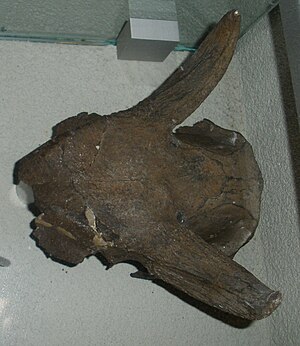Dubois' antelope
| Dubois' antelope | ||||||||||||
|---|---|---|---|---|---|---|---|---|---|---|---|---|

Duboisia santeng , skull |
||||||||||||
| Systematics | ||||||||||||
|
||||||||||||
| Scientific name of the genus | ||||||||||||
| Duboisia | ||||||||||||
| Stremme , 1911 | ||||||||||||
| Scientific name of the species | ||||||||||||
| Duboisia santeng | ||||||||||||
| ( Dubois , 1891) |
Dubois' antelope ( Duboisia santeng ; junior synonym : Antilope modjokertensis ) is an extinct species of mammal from the subfamily of the Bovinae . The species was endemic to Indonesia during the Pleistocene . The species became extinct about 750,000 years ago. Dubois' antelope was first described by the Dutch paleontologist and geologist Eugène Dubois in 1891.
The closest living relatives are the Nilgau antelope ( Boselaphus tragocamelus ) and the four-horned antelope ( Tetracerus quadricornis ).
Appearance
Dubois' antelope was a small to medium-sized antelope. It was estimated at 32–84 kg. Both sexes had horns that were 6–9 cm long.
Behavior and habitat
Duboisia santeng lived in dense forests with a closed canopy. The animals were also able to colonize medium to very humid forest biotopes. Based on the teeth it could be proven that this species mainly ate leaves and occasionally harder vegetation.
This species belongs to the so-called Trinil fauna from the Pleistocene Java . The species shared its habitat with Stegodon trigonocephalus , Bos palaesondaicus , the Indian muntjak ( Muntiacus muntjak ) and Bubalus palaeokerabau . Predators of the Trinil fauna were the Trinil tiger ( Panthera tigris trinilensis ) and the Trinil wild dog ( Mececyon trinilensis ).
Individual evidence
- ↑ Christine Hertler, Yan Rizal (2005): Excursion guide to the Pleistocene Hominid sites in Central and East Java. JW Goethe University, Frankfurt, Germany / ITB, Bandung, Indonesia
- ^ A b Roberto Rozzi (2013): The enigmatic bovid Duboisia santeng (Dubois, 1891) from the Early-Middle Pleistocene of Java: A multiproxy approach to its paleoecology . In: Palaeogeography, Palaeoclimatology, Palaeoecology . Vol. 377: 73-85.
- ↑ Fachroel Aziz (1992): Early Dispersal of Man on Islands of the Indonesian Archipelago: Facts and Controls . In: Anthropological Sciences . Vol. 103 (4): 349-368.
- ↑ a b Fossil Bovidae from the Malay archipelago and the Punjab by Dr. DA Hooijer, Rijksmuseum van Natuurlijke Historie, Leiden
- ^ Julien Louys (2007): Characteristics of Pleistocene megafauna extinctions in Southeast Asia (PDF). In: Palaeogeography, Palaeoclimatology, Palaeoecology . Vol. 243: 152-173.